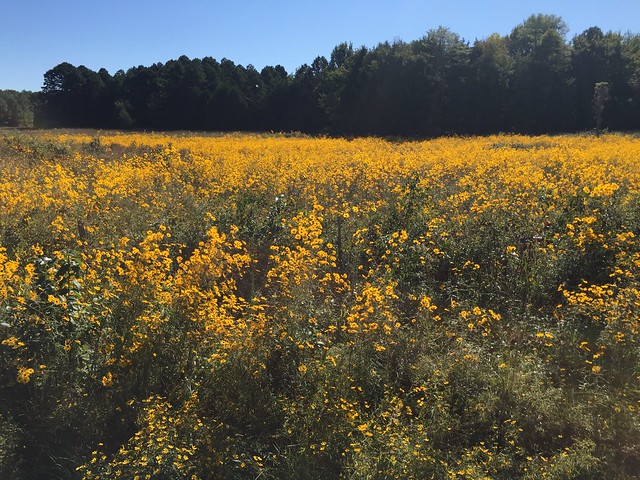Resource Library
Plant of the Week: Yellow Wildflowers of the Fall
Driving the back roads of Arkansas and away from the interstate mowing crews that favor the slicked off look, it becomes quickly apparent that yellow is the dominant color of our autumnal wildflowers. It’s not just a few yellow flowers, but a lot of them. Why does nature have a preference for yellow when there are so many other shades to choose from?
If we look at the plants involved, it quickly become apparent that most of them are in the daisy family. Tickseed sunflower (Bidens aristosa), half a dozen or more goldenrods (Solidago sp.), three or four species of rosinweeds (Silphium sp.) and a number of late summer sunflower species (Helianthus) make up the bulk of the roadside display in September and October. Asters may provide a bit of blue as a counterpoint to all the yellow, but yellow still dominates.
After considering this for several weeks, I’ve concluded that there are several things that lead to this bright and sunny display. This is a thought experiment – the botanical equivalent of deducing how many angels can dance on the head of a pin – so take it with a grain of salt.
First, it is significant that most of fall blooming wildflowers are in the daisy family. Whites, blues and oranges are not uncommon flower colors in the daisy family, but yellow flowers are probably at the top of the frequency list. Of the fall blooming species mentioned above, some shade of yellow is the only choice available.
When we look at wildflowers, we see them in the visible spectrum. A yellow flower is yellow to us because the other light waves of the visible spectrum are absorbed while the yellow portion of the spectrum bounces back to our eye. But we are just hapless bystanders; it is what the bees and butterflies see that really counts. These insects see into the ultraviolet spectrum and yellow flowers often look quite different to them. Many of the fall blooming yellow flowered wildflowers appear white, often market with a bulls-eye of red or pink, when view under ultra violet light. These plants are insect pollinated, so the patterned markings the pollinators see is what really matters.
Size is important in our seeing them. They are big. While much of Arkansas is, or was, wooded, the fall blooming plants are adapted to prairie or savannah habitats full of tall grasses, not the deep shade of the forest. So, when we see them, they are along the roadway where the light is abundant.
Part of the reason for their large size is another shared characteristic of the daisy family; they are short day plants. Like many fall blooming garden plants – think of garden mums for example – the plants do not initiate flower buds until after mid-July. This gives them several months to grow the framework that will hold the flowers above the tall grasses of their ancestral homeland.
In addition to producing seeds for their own self-preservation, these fall bloomers fill an important niche for the rest of the ecological community, especially birds. Several of the fall bloomers – especially the sunflowers and rosinweed species – produce large, oil-laden seeds that are sought after by songbirds. Goldfinch especially favor these roadside “weeds.”
Most of these fall bloomers can be grown in the garden, but they are not for those who demand well-mannered and tidy plants. They are large and rambunctious and the uninitiated might think of them as a weed patch for a lot of the year. But, for those of us in the know, they are but another face of the beauty of nature.
For more information about horticulture or to see other Plant of the Week columns, visit Extension’s Website, www.uaex.uada.edu, or contact your county extension agent. The Cooperative Extension Service is part of the U of A Division of Agriculture.
